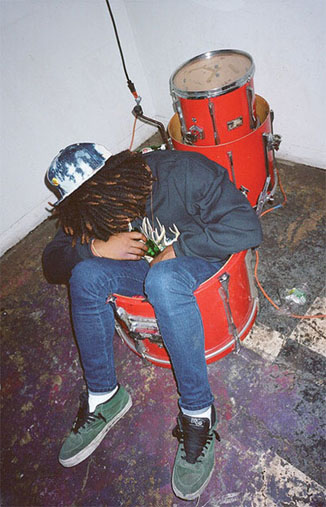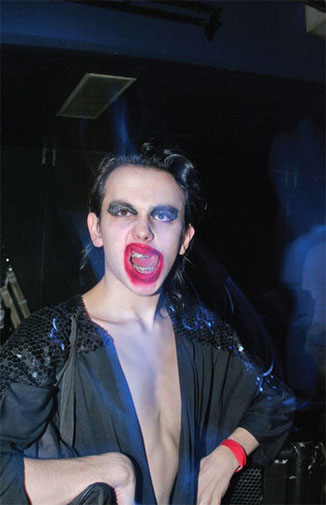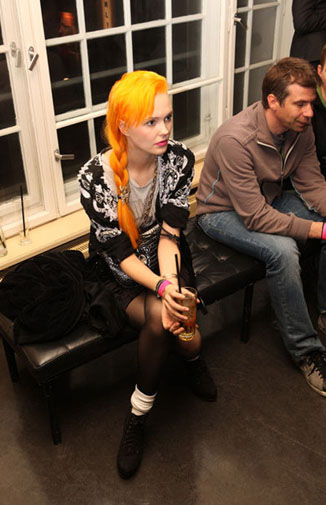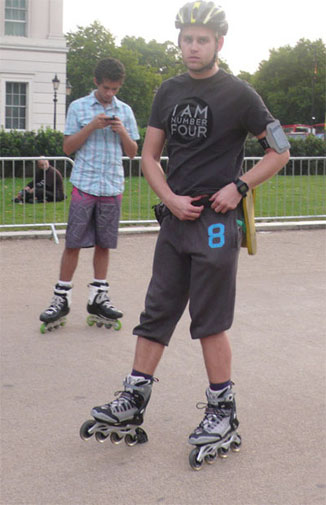<page4>
Do's and Don'ts
We have discovered the ways in which identity,
sexuality, gender and consumerism is redefined by Vice. Their section called
'Do's and Don'ts' provides yet another piece of the puzzle in how the subcultural
identity is created and defined. Do's and Don'ts are a collection of street
photography that captures everyday people and provides a comedic commentary on
that person's outfit or public behavior. The 'Do's' reinforce and congratulate
that identity, while the 'Don'ts' punish that individual. While this segment of
Vice is meant fore purely comedic purposes, it provides insight in to what behaviors
are 'allowed' by Vice and which are not. The Do's and Don'ts operate as modes of
identity policing. The subjects of Don'ts are either people that are unaware and
ignore the culture or are 'imposters.' Hills describes that impersonation within
fan culture is criticized within the subculture (Hills, 169).
"Cultural work therefore has to be done to represent impersonation as 'bad'
(feared and feminized) if not an abject loss of self" (Hills, 168). While this
concept of impersonation refers to a fan attempting to resemble or act like a
famous person, the status of subculturists deemed as 'don'ts' places them within
a similar framework of failing to assimilate. Most of the photos are taken on the
streets of urban areas. James Heslin contends that deviant lifestyles expressed
on urban streets creates great visibility to the existence of the subculture, and
contributes to the public discourse of that city (Heslin, 233). Thus, the
performativity of identity as seen through street-wear is made visible not
only by the camera's gaze (in the case of Do's and Don'ts) but also by the
subjects' status as city-dwellers. The presence of deviance in the public sphere
also has the potential to attract a touristic perspective by those witnessing the
subculture member (Heslin, 235). While not all of the subjects of Do's and Don'ts
are subculture members, more often than not the 'Do's' are. The implications of
this are such that public identity as expressed through clothing and behavior are
encouraged when they meet the standards of Vice's counter-culture. The writer in
the photo's caption punishes those who do not are not performing this particular
public identity.
| "Who are the suckers out there paying money to rent
and sleep in an apartment when you've still got half a case of Grolsch at
the practice space and Consecutive Norms aren't going to show up until at
least ten the next morning?" |
 |
The first 'Do' is a picture of a fashionable young man with
dreadlocks, cradling a beer, seemingly asleep in a plastic bucket.
For this photograph,
the subject is presumed to be part of the inside culture. He is presented as a
die-hard alternative music fan with a superior knowledge about obscure bands.
The subject is also assumed to be homeless or a squatter, thus highlighting his
subcultural authenticity. For the viewer/reader, they are interpellated by the
image and caption. Either the reader understands the joke and the type of person
that is being communicated and is therefore part of the group, or he/she does not
and is therefore excluded. While the caption appears to be making fun of the
individual in question, there is an element of reaffirmation for the subject.
Vice is interpreting the individual as part of the subculture and an example of
its cultural capital. This picture operates in a similar way to the 'party shots'
in that it is a candid picture of a person, however the caption as an anchor
recontextualizes the photo to have greater meaning and implications to the viewer.
 |
"If I knew that one day I would have a son who would
grow up to be just like this, I would have let that pregnancy come to full
term. I wouldn't regret every choice I'd made up to this point and book an
appointment at my local Planned Parenthood. I wouldn't sit in the waiting room
all by myself and wish I was dead because of what you did to me." |
The response to this 'Don't' is more extreme than the
pervious example. This is an example of the fear and anger that is expressed
towards impersonators or 'poseurs.' The caption is violent in nature, suggesting
that this individual should have been aborted. However, the writer as saying the
opposite of what the reader presumes he/she means. The way the humor is constructed
through thick sarcasm, which is another common technique for Vice writers. Hills'
claim that the impersonator is seen as lacking in a complete loss of identity and
is feminized or weakened by the fan culture is clearly seen here. Because the
individual has 'failed' to perform to Vice's standard of 'cool', then he is wished
to never have been born. This example highlights how exclusionary practices based
on cultural elitism help to define what the subculture is by explaining what it is
not. The presence of impersonators of counter-culture are met with fear because
they threaten the overall public image that those at Vice are trying hard to
reinforce.
| "You know the scene in Cape Fear where Robert De Niro
brings Illeana Douglas back home? You know the scene where he chews into her
face? If you leave me, I will torture you. I will hunt you down and skin the
hair off of your perfect head." |
 |
The third picture is a 'Do.' It depicts an attractive,
young woman with fashionable clothes and dyed hair. Similar to the example before,
there is a confrontational and violent tone to the comment. A scene from a movie
that perhaps only someone with a superior knowledge of film would understand first
contextualizes the comment. Similar to the first example, the reader is required to
be 'in' to understand why this person is a 'Do.' Secondly, because the subject of
the photo has a 'perfect [alternative] head' of hair she is met with a particular
violence and desperation. The violence is threatening, and carries with it
potentially misogynistic tones. The reader is invited to engage with this strange
fantasy and again we see another attempt by Vice to intertwine sex with violence.
The overall message seems to be that subcultural women are primarily either
masculinized party-girls or sexualized objects that you want to hurt.
 |
"I wonder how many other people missed the word
"number" on his t-shirt and were like, "Yeah, we got it." |
The third photo is a 'Don't' and is an example of a
mainstream member of society criticized for not belonging to the subculture. The
caption is referring to the rollerblader's t-shirt. Here, the subject is criticized
not for being an imposter but for not caring about being 'cool' or fashionable.
The rollerblader is thus made to seem childish and un-masculine. In this case, Vice
attempts to define its culture by outlining what a good 'alternative' individual,
what a 'bad' subculturist looks like and what an complete outsider is.
Vice's visual culture is represented in a variety of ways through their photography.
The candid 'party shots' and documentary-style photos show how those within the Vice club operate within public culture.
These images have power because their contextualization within the 'real' interpellates the viewer to question their own
public identity as compared to the 'friend of Vice.' The fashion photography focuses on the representation of sex, gender
and style within occasionally compromising contexts. These images reinforce heteronormativity yet appear to be possibly
aware of this discourse. Vice could thus be playing with what we know about sex and gender within fashion. This confusion between art,
sexuality and violence is further expressed within the artistic photo shoots. These images create strong associations between the female
form and an intense negativity. Finally, the Do's and Don'ts take the Vice perspective to the street, where certain identities are
encouraged and some are admonished. Those who fail to perform as authentic subculturists are labeled as impersonators. Individuals
who are unaware of the alternative tropes are criticized for not knowing. This type of critique further defines what Vice culture is
and what it is not. Their slogan, "The Definitive Guide to Enlightening Information" is indicative of the inherent hubris yet cheekiness of the
corporate image. Vice subverts mainstream culture while strictly reinforcing an image that becomes almost impossible to maintain. You
are either with Vice or against them and they probably hate you regardless.




